Subtotal: $
Checkout-

Is There a Right to Have Children?
-

The Stranger in My House
-

The Sins of the Fathers
-

My Father Left Me Paperclip
-

Decoding the Bible’s Begats
-

The Name of My Forty-Sixth-Great-Grandfather
-

Somewhere in Chessington
-

Singing the Law
-

Desiring Silence
-

Uncle Albert
-

Soldier of Peace
-

The Chocolate Ice Cream
-

Poem: “The Revenant”
-

Poem: “L’esthétique de la Ville”
-

Poem: “When You Pursue Me, World”
-

Gazapillo
-

Editors’ Picks: God Loves the Autistic Mind
-

Editors’ Picks: Damnation Spring
-

Editors’ Picks: Life between the Tides
-

The Faces of Our Sons
-

Remembering Tom Cornell
-

Letters from Readers
-

Monica of Thagaste, Mother of Augustine
-

Covering the Cover: Generations
-

A Legacy of Survival
-

Daughter of Forgottonia
-

Giving Your Children Your Words
-

Book Tour: On Being a Good Ancestor
-

Ten Theses on Intergenerational Stewardship
-

Inheriting Mental Illness
-

Yearning for Roots
-

Fear of a Human Planet

Reviving the Village
By returning to the land, African Christians seek to heal the ravages of ecological and ethnic violence.
By Emmanuel Katongole
December 16, 2022
Available languages: español
Next Article:
Explore Other Articles:
During the genocide in Rwanda in 1994 I was a graduate student in Belgium. We had just watched the BBC evening news with images of dead bodies in streets, churches, and rivers and were leaving the common room in stunned silence when a colleague turned to me and blurted out, “Why do you Africans always kill your own people?”
While grossly unfair and insensitive – I was born to Rwandan refugees in Uganda – this question has followed me through almost three decades of peacemaking and studying two issues at the heart of the question. First, the issue of identity: What does it means to be African? And second: Why is violence so prevalent on the African continent?
Examining the intersection between identity and violence in Africa has led me to see that the 1994 Rwanda genocide is not separable from but deeply connected to other forms of violence in Africa – ethnic, religious, and ecological. Many people associate violence in Africa with a primitive “tribal” outlook, but this is not the case. There is something distinctly modern about all these forms of violence. Even what usually passes under the label of ethnic violence is a recent phenomenon that reflects unsettled questions of belonging and of who has access to the social, political, economic, and cultural institutions of modern Africa.
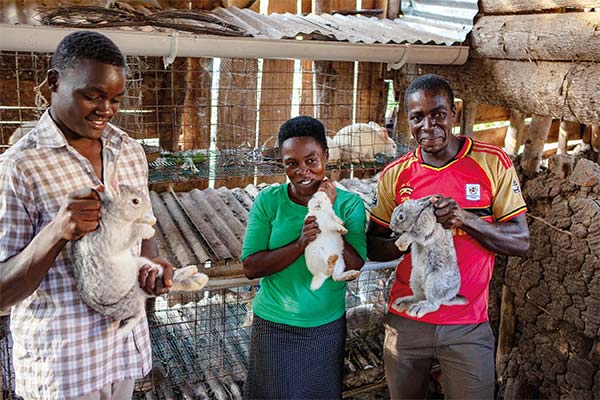
Trainees raise rabbits at the Bethany Land Institute’s model farm in Uganda. All photographs courtesy of the Bethany Land Institute.
Ethnic, religious, and ecological violence in Africa does not constitute three separate forms of violence, but modalities – a better word might be “echoes” – of this ongoing crisis of belonging. One can trace this crisis to a story, first told by European colonialists, in which Africa is at once rejected – “Nothing good can come out of Africa” – and projected as the beneficiary of the European project of civilization, pacification, and development. This story lives on and continues to shape the social, political, and economic institutions of modern Africa, resulting in the image – and thus reality – of Africa as a perpetually disabled, deficient, and violent continent.
Can Christianity offer resources with which to navigate this uniquely modern crisis of belonging in nonviolent ways? Or will Christianity simply amplify it, as often seems to be the case? For Christianity to be helpful, it will need to tell a different story, one that fosters new forms of community that defy static notions of identity, engendering new economic and ecological possibilities in modern Africa.
After all, Christianity is, in its essence, a story: the story of God’s love manifested in Jesus’ self-sacrificing love on the cross, ushering in for his followers a new identity, a new community, a new people that expands to incorporate all people, and a new social order infused with love. In my latest book, Who Are My People?, I tell stories of Christian activists and communities in Africa whose examples confirm that this is not some utopian dream or merely spiritual idea; it is a concrete social reality today. In the end, it is the antidote to Africa’s violent modernity.
Three Faces of Africa’s Ecological Crisis
The village, the slum, and deforestation are three interrelated faces of the ecological crisis in Africa. Though over 65 percent of Africa’s population live in rural communities, there is a growing impoverishment of life in rural Africa, with increasing water poverty, food insecurity, and lack of viable economic possibilities. Most villages have no paved roads, electricity, health care, or other basic social services. The late Tanzanian president Julius Nyerere once said that while the rest of the world is trying to reach the moon, in Africa we have yet to reach the village. He was speaking not only of the difficulties of physically getting to the village, but of a mindset that ignores the village as irrelevant to development. Still today, in the minds of many government and international development agencies, the village represents what it represented for the colonialists: an image of all that is backward and primitive, all that should be left behind in order to realize the dreams of modernity and civilization.
According to this mindset, the city represents the promises and dreams of civilized modernity. It is therefore not surprising that, lured by dreams of progress, employment, and better living conditions, millions of people, especially the young, decide to migrate to the cities. And while cities in Africa are growing fast, its slums are exploding at a terrifying rate. The 2016 World Economic Forum on Africa predicted that Africa’s population of 1.1 billion will double by 2050, with more than 80 percent of that population living in cities and the majority living in slums (“informal settlements”) where poverty and violent crime are widespread and basic public utilities such as clean water, reliable electricity, and law enforcement are absent.
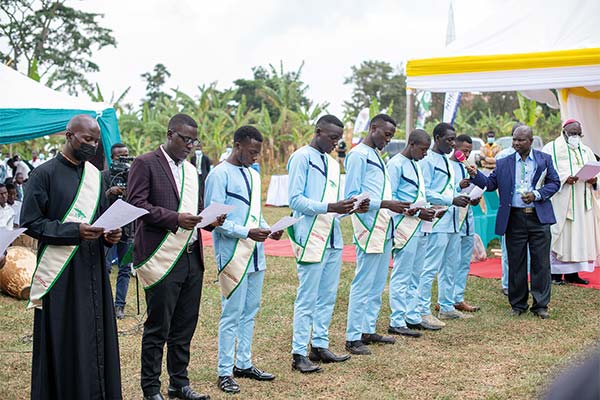
The first cohort of sixteen trainees is officially commissioned in early 2021.
Rapid deforestation is another face of Africa’s growing ecological crisis. According to the UN Food and Agriculture Organization, old-growth forests in Africa are being cut down at a rate of more than 4 million hectares per year, twice the world’s deforestation average. For example, in Uganda forest cover diminished from around 10.8 million hectares in 1900 to 4.9 million in 1990 to only 1.9 million in 2015. A number of factors contribute to this depletion of Africa’s forests – population growth, commercial logging, agricultural expansion, and the use of firewood as a predominant source of energy.
These three faces of Africa’s ecological crisis – the burgeoning slum and the vanishing village and forest – confirm a number of things. First, they are evidence of the extent to which the cry of the earth and the cry of the poor are interconnected, as Pope Francis expresses it in Laudato si’. In fact, they reveal the unique modernity underway in Africa, characterized by what journalist Christian Parenti has called a “catastrophic convergence” of poverty, violence, and ecological degradation. As Pope Francis notes, addressing this triple challenge requires an integrated approach that addresses poverty, cares for creation, and advances human dignity for poor and marginalized people.
Ethnic, religious, and ecological violence in Africa do not constitute three separate forms of violence. They are echoes of the same ongoing crisis of belonging.
Second, they represent forms of what Princeton professor Rob Nixon calls “slow violence.” These gradually unfolding calamities remain largely imperceptible, undetected, and untreated. Incidents like flooding and mudslides are just symptoms of the underlying violence. To refer to climate change and ecological degradation as “slow violence” is not simply to say that they lead to violent outcomes (destruction of lives and property) or that they trigger violence (conflicts over diminishing land and water resources), which they obviously do. It is to recognize them, as Kevin J. O’Brien writes in The Violence of Climate Change, “as the product of a destructive system that degrades human lives, other species, and the world upon which all living beings depend.”
Third, they point to a shifting relationship with nature in general, and land in particular. Perhaps the most obvious evidence of this shift is the rapid rate of deforestation and the destruction of natural ecosystems, but no less important is the rural-to-urban exodus that leads to the growth of slums and the abandonment of villages. Africans’ changing relationship to the land is the result of a modern outlook that eschews the traditional spiritualities which encouraged an intimate, symbiotic, and sacred relationship to the earth, which was considered “mother.” Modern people view these spiritualities as backward and primitive, and see nature primarily as a resource. Development economics encourages this worldview with its focus on a “cash economy” and its exploitative and extractive relation to the land.
As I’ve said, underlying this modern outlook is a crisis of belonging, which Acholi poet Okot p’Bitek captures well in his classic set of poems entitled Song of Lawino, Song of Ocol. Song of Lawino is a bitter complaint – a lamentation by Lawino about her educated husband, Ocol, who has not only left her but abandoned the traditional ways of his people, whom he now looks down upon as primitive and pagan. He abuses all things Acholi and considers all the ways of his people backward. Lawino appeals to her husband to “return home” and learn to respect the traditions of her people, whose roots “reach deep in the soil.”
Ocol will have none of that. For him, the way forward is not to return home but to “smash” the primitive customs and embrace the dreams of progress and civilization represented by the city:
… I see the great gate
Of the City flung open,
I see men and women
Walking in …
Why don’t you walk in with the others?
In the end, however, Ocol offers Lawino no choice:
You have only two alternatives my sister
Either you come in through the City Gate
Or take the rope and hang yourself.
It is this total dismissal of tradition and the village – and the acceptance of a Western idea of progress – that shapes the dreams and aspirations of modern Africa. It is enshrined in a particular model of economic development. As economist Jeffrey Sachs notes in The End of Poverty, the “ladder of economic development” involves a “progression of development that moves from subsistence agriculture toward light manufacturing and urbanization, and on to high-tech services.” This is the dream of economic development promoted by the World Bank, IMF, and other development agencies and embraced by African leaders. What is increasingly obvious, however, is that this vision of inevitable progress, of climbing up a ladder of economic development, is leaving a huge ecological footprint of deforestation, pollution, mass poverty, and mass unemployment in much of sub-Saharan Africa.
Demonstration Plots for a Different Future
What would it take to redirect this modernity? What would a new economic vision – an “integral ecology,” as Pope Francis describes it, one that fights poverty, protects nature, and restores human dignity – look like in Africa? Pope Francis points to the need for “spiritual conversion,” and Lawino appeals to Ocol to “return home” to rediscover the wisdom of “our people” whose roots reach deep into the soil. Are there any experiments in this spirituality of deep connection and belonging to the land that could testify to the possibility of a new modernity in Africa? The Songhai Center in Benin and the Bethany Land Institute in Uganda are two such models.
In 1985 Godfrey Nzamujo, a Dominican priest, founded the Songhai Center in Porto-Novo, Benin, West Africa, to address the challenges of poverty, food insecurity, and unemployment in rural communities. To date the Songhai Center has trained over two thousand young people in sustainable and organic farming, value-chain practices, and business-creation skills. More than half these students have gone on to create sustainable farms in their own villages.
What makes Songhai Center an effective answer to the catastrophic convergence of development economics, poverty, and environmental degradation in Africa? Nzamujo identifies three elements at the heart of his efforts.
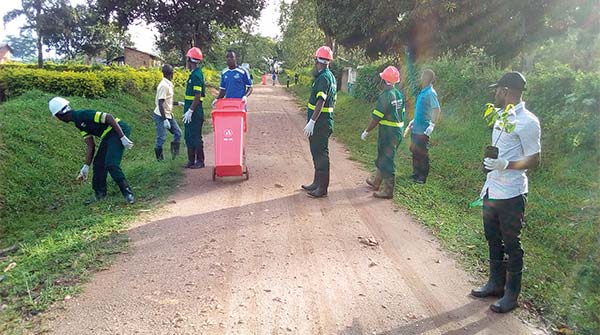
Bethany Land Institute students take part in community service in the surrounding villages.
First, a clear diagnosis of modern Africa’s challenges. The story of Songhai Center goes back to the 1983–85 famine in Ethiopia that led to the deaths of over four hundred thousand people. At that time Nzamujo, who had earned doctorate degrees in electronics, microbiology, and development science, was a research professor at the University of California, Irvine. As he watched images of emaciated African children on TV, he felt shame and anger. The images were reinforcing the standard image of Africa as a “hopeless” continent of bloody wars, famine, and poverty, and of its people as helpless victims extending their hands begging for a handout. Africa need not be like that, Nzamujo protested. In his mind was the memory of the great civilizations in Africa’s history, like the West African empire of Songhai in the fifteenth century, which attracted scientists, scholars, students, and merchants from far and near, and built cities like Timbuktu, a prestigious center of learning. What went wrong, Nzamujo wondered, to bring Africans to the point where they seem unable even to feed themselves?
Africa’s problem, he surmises, is the “trap of poverty,” an “incapacity to effectively harness the opportunities before us.” While empires like Songhai confirm that this capacity was available in Africa’s past, we have largely lost it and “succumbed to the logic of poverty.” Africa’s problems of unemployment, poverty, famine, and environmental degradation are all manifestations of this faulty modern logic. Underlying the trap of poverty, Nzamujo notes, is an internalized belief that nothing good comes out of Africa. Accordingly, we respond to Africa’s needs using Western solutions and models. This leads to a slavish mimicry of Western habits of superficial consumption. Shaped by a colonial heritage, we perpetuate forms of development economics that primarily benefit less than ten percent of the population. The result of these modern policies, Nzamujo tells me, has been the “erosion of dignity” and the destruction of “Africa’s internal capacities to meet the challenges before her.”
Secondly, the need for a new imagination. What is needed, according to Nzamujo, is “a new way of looking at ourselves, the world, and others” and “another way of placing ourselves in the world.” This will require a paradigm shift, with “Africa learning to harness her internal capacities and local knowledge.” While the idea of a paradigm shift might sound heady, for Nzamujo it is a simple thing that begins with, and happens through, working with the land and changing the way we grow food. “God has given us everything we need right here.” Working the land will not only stem the problem of rural-urban exodus, it “will recreate the villages as viable social economic units,” and thus help in the creation of a new African society. This possibility of reinventing African economics from the ground up led Nzamujo to resign his position at the University of California and return to rural Africa to work on the land.
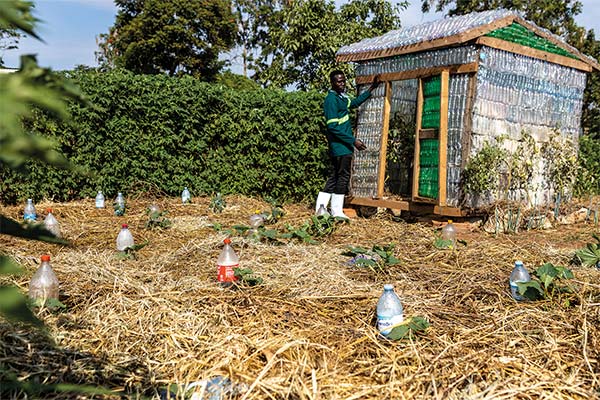
This greenhouse was created by reusing old plastic bottles.
At the heart of Songhai Center is what Nzamujo describes as a simple logic – namely, that everything is connected. The Songhai model is an integrated system of crops, livestock, and aquaculture, where waste from one unit becomes food for another. This is the primary production, supported by the secondary production of technology, processing, and manufacturing, and the tertiary level of services, such as market, restaurant, and lodging. Nzamujo hopes this microeconomy can be replicated throughout Africa, turning villages, which modernity has coded “hopeless,” into viable economic and social units.
Thirdly, a spirituality underlies Nzamujo’s work at Songhai Center. This spirituality is an invitation not to fight nature but to work with her. Nzamujo understands his work with the land at Songhai as “a form of contemplation, and a prayer, which is but a way of entering into the mystery of reality.” He refers to Songhai as a “sermon” because “all we are trying to do is to contemplate the dance of nature” and to “imitate the way nature works.” Nzamujo sees great affinity between his being a Dominican and his scientific background, in particular his appreciation of quantum physics. The latter, unlike the Newtonian physics of external forces acting on matter, is about discovering the interconnected nature of reality. Accordingly, at Songhai there is no dichotomy between nature and science, between faith and practice, between creation care and scientific production, or between agriculture and technological innovation. Scientific innovation, far from being an attempt to “subdue” or “tame” nature, is just another dimension of the invitation to “enter into the dance of nature” and an example of harnessing the interconnectedness within nature to advance the flourishing of both the human community and of nature herself.
Entering the dance of nature reveals another crucial reality: that human beings are an integral part of the universe and not masters who stand apart from it. Birth leads to death and decay leads to renewal, just as light leads to darkness and darkness leads to light. The more we become connected with the earth, the more we discover that just like the rest of creation, we are part of this cycle of death and resurrection. This became personal for Nzamujo after his own cancer diagnosis. He writes, “If we let go and accept suffering and embrace our death, then we are released. We become fully alive, as we become reconnected to the earth’s fragile fertility. … The power of the resurrection can only be accessed from our freedom to die. The experience of our fragility or our limitedness becomes a pathway to a fuller life.”
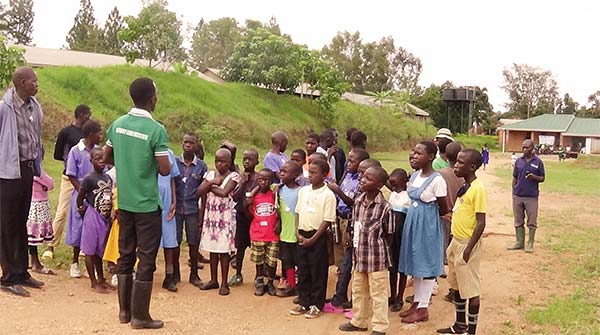
Paul, a trainee, leads a group of local schoolchildren in a tour of the Bethany Land Institute’s campus.
P’Bitek’s Lawino appealed to her educated husband to “return home” and rediscover the ways of his people, whose roots “go deep into the soil.” This is what Nzamujo has done. But his return is not to a pristine subsistence mode of living on – and off – the land. Rather, it is a return to a sense of belonging to the earth. We see at Songhai a new synthesis that overcomes the usual misleading either/or binaries: either tradition or modernity, backwardness or progress, village or city, spirituality or technology, nature or science, past or future. What we see at Songhai is the invention of a new modernity, one that is not built on the rejection of Africa but whose roots go deep, both literally and metaphorically, into African soil. This soil is in itself a mystery, within which one also discovers that everything is connected. The integration of science and technology with the skills of crop, animal, and fish farming reflects and enhances this interconnectedness.
Inspired by what I witnessed at Songhai, and later also by Pope Francis’s Laudato si’, I decided to return to Uganda from my post at Notre Dame University to help establish Bethany Land Institute, another center that seeks to cultivate this vision of integral ecology among young people in rural communities. With two other Ugandan Catholic priests, Cornelius Ssempala and Anthony Rweza, I acquired ninety-five acres in Luwero, Uganda, site of some of the bloodiest clashes in Uganda’s long civil war. In the Bible, Bethany is a place of refuge where Jesus often returned to teach, rest, and find comfort among friends. We named our institute after this place and our programs after Jesus’ three friends there: Mary’s Teaching Farm, Martha’s Market, and Lazarus’ Forest.
In 2021 we welcomed the first cohort of sixteen students, called Caretakers, into an intensive two-year residential program to learn practices of regenerative agriculture, reforestation, and entrepreneurship that they can then take back to their villages. The Caretakers commit to training four apprentices on their own farms in the following two years, and to freely sharing their knowledge with everyone. In this way, the Caretakers will become an ever-expanding network of knowledgeable, caring, creative farmers.
A New People and a New We
I’ve focused here on ecological violence. A similar analysis of Africa’s ethnic and religious violence reveals the same underlying crisis of belonging, which reflects the persistence of a colonial imagination in the so-called postcolonial age. Here too, what we need is a new mindset, a new outlook, a new imagination. Christian identity, it seems, could offer such a new way of looking at ourselves and others, of “placing ourselves in the world,” as Godfrey Nzamujo puts it. But since life in Christ is an undeserved gift, it is a way of being placed by God in the world. Christian identity, however, is not static. Our placement in the world is an invitation to constantly cross boundaries into an ever-expanding sense of “my people.” This is a “new we” that moves beyond the boundaries of race, nation, ethnicity, gender, or tribe.
Here one can rightly speak of Christian spirituality as politics. The late Archbishop of Bukavu, Emmanuel Kataliko, invokes this politics of spirituality, and its apparently contradictory logic of “simplicity” and “excess,” when in 2000, at the height of war in the Congo, he writes a pastoral letter from exile to the Christians in Bukavu. In it, he reminds the beleaguered Christians that “the logic of the gospel is a logic not of power but of the cross.” In the end, this simple message is the Christian response to the violence in Africa. For, as Kataliko reminds the Christians, “the only response to the excess of evil is the excess of love.”
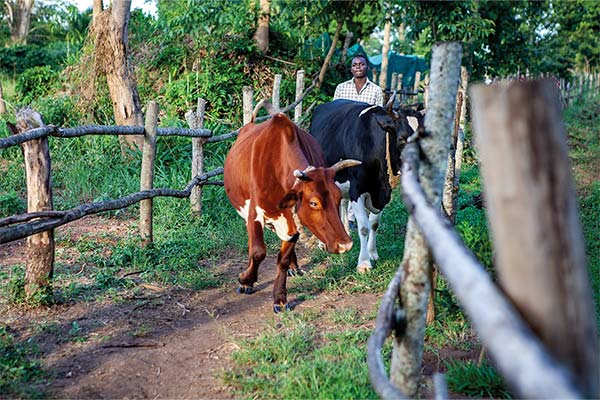
Amid the recurring and widespread suffering and wanton sacrificing of African lives, Nzamujo and other Christian activists I have interviewed across the continent have come to see their own suffering within a bigger drama: the story of God’s own self-sacrificing love. This means that healing the wounds of Africa’s violence will involve another form of violence, which Oscar Romero has called “the violence of love.” For these men and women, God’s love not only allows them to embrace the reality of their suffering, it “heals,” “liberates,” and “releases” them from fear, unleashing a new freedom. Out of this newfound freedom, they are able to “invent” new communities and practices through which they seek to heal, restore, and renew other victims of violence. Through these “inventions” one is able to grasp the possibility of a radical transformation of Africa’s suffering: from the sacrificing of Africa to the true sacrifice (sacra facere is to make sacred) of Africa, from sacrificing others to self-sacrificing service, from a love of violence to the violence of love.
There may be no good answer to that terrible question posed to me back in 1994: “Why do you Africans always kill your own people?” But I hope that in the midst of the madness of ongoing violence, places like Songhai and Bethany Land Institute can help us see evidence of another future emerging in Africa.
Already a subscriber? Sign in
Try 3 months of unlimited access. Start your FREE TRIAL today. Cancel anytime.











































Tessa Carman
Generations has been such a rich issue! I particularly have enjoyed “Reviving the Village.” Fr. Emmanuel and Fr. Godfrey's Christ-centered vision reminds me of Wendell Berry's work, in that they too recognize that the health of land and people are deeply intertwined, and that there is not only a great need for creativity in the work of healing and rebuilding our relations with God, each other, and our land, but also that the health of rural areas, and of the basic question of how we grow our food, is foundationally related to the health of cities, as well as of our own spiritual well-being. There must be—I hope there are—similar projects in the United States: we too desperately need to “revive the village,” to train others to return to their places and rebuild, to reweave aright our relationships on every level, starting with the soil of our hearts and of our land.
Wendy Phillips
Yes and Amina! With over 20 years of working with 11 villages in rural Zimbabwe, what you describe offers real hope for the declining way of life that has immense knowledge and joy. Thank you!